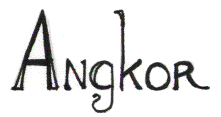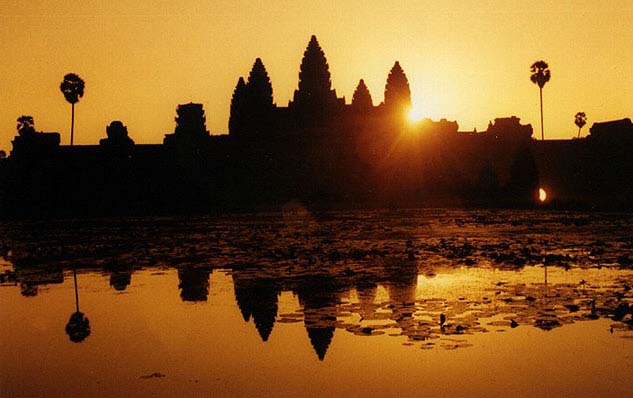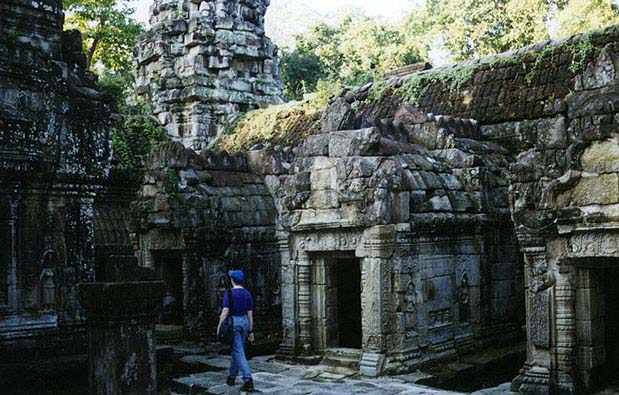
Temples Amid the Vines
 |
| Sunrise at Angkor Wat |
The next morning, November 10th, Rang picked us up at 5:15 AM so we could make it to Angkor Wat in time to see the sunrise. The streets of Siem Reap were empty. When we arrived at Angkor Wat, we found that it was empty too. We looked around for the best shot and decided to stake out a corner of one of the reflecting pools. Because it was dawn and we were directly in front of a muddy swampy pool, the mosquitoes were out in full force. I put on my nylon anorak, pulled the hood over my head, crouched down and waited for the sun to rise. Andy had brought a Khmer scarf and he wrapped it around his head. As the sun rose higher, the number of mosquitoes decreased, and the number of tourists increased. Monks from the building next door began their morning chores, sweeping the courtyard and collecting the wash.
Finally, the sun rose to just the right height, so we took some shots of Angkor Wat silhouetted by the sun, reflected in the pool, from the left corner of the water, from the right corner of the water, and from just about every other angle until we decided we'd taken enough pictures. As we walked back to the causeway, an amputee held out his hat. Children followed close behind us. I don't remember looking back at Angkor Wat. I should have. That was the last time we would visit it.
We met Rang back at the car. He was so nice to us. He taught us how to say "thank you very much" in Khmer - something like "ah cone chair-eye." That is my own personal interpretation of the spelling of course. To pronounce it correctly, you have to flip the front of your tongue against the roof of your mouth between the "chair" and the "eye." We got it after a while, but in the meantime, Rang, Andy and I laughed at our pitiful attempts. (Just plain old "thank you," by the way, is just "ah cone.")
From Angkor Wat, we took a brief detour back to the Bayon to get some morning photographs. Then we began to make our way through what is known as "The Big Circuit." Our first stop was a mysterious maze of fallen rock and endless hallways. Very little restoration has been done to Preah Khan, so I really felt like Indiana Jones tromping through some abandoned temple. Walking toward the ruins, we passed a line of statues lined with cobwebs. Light poured in from the thick canopy of palm trees. The sun came down in shards of light, illuminating the morning mist. A boy, maybe twelve years old, followed us through the arched entryway and into the ruins. He didn't say anything. He just followed.
 |
| Main Courtyard, Preah Khan |
Preah Khan is truly a maze. I don't know if it was that we were there so early or just that most tourists don't go there, but the temple was completely abandoned. We were the only ones in the entire Preah Khan complex. Intricate spider webs spanned across the archways. Detailed reliefs rose out of stone pillars. Green leaves draped in from above; green grass crept in from below. At one point we wanted to press further into the ruins, but a jagged pile of rocks stood in our way. Andy started to turn back to look for another path, but the boy spoke up for the first time and pointed to the pile of rocks.
"Very nice this way," he nodded.
We decided to follow his lead. He navigated his way over the rocks, and we followed him. Some of the stones were slick with moss, and a couple times I almost lost my footing, but it turned out to be worth the trouble. On the other side and around the corner was a large courtyard. Stone lions stood guard next to a platform. A ruin surrounded by columns was positioned at the far end. We found a pond choked with lily pads under the shade of the palm trees.
Like many of the magnificent ruins at Angkor, Preah Khan was built during the reign of Jayavarman VII. The name, Preah Khan, means "Sacred Sword."
The name, Preah Khan, means "Sacred Sword."
Past the courtyard, the stone floor dropped off into a muddy plain. It wasn't so muddy that we couldn't walk on it though. A small thin snake with dull green stripes hugged the walls of a crevice. I bent down to watch it slither off into the cracks between the stones. When it was gone, I joined Andy and the boy in the muddy plain. Every time I took a step, dozens of little frogs, each about the size of my thumbnail, darted around. From the plain we could see how a large, canvas colored tree had grown right through the ruins, pushing its roots through the walls and across the ceilings.
Except for our footsteps and the chirping of various insects and frogs, the ruins were quiet. Hiking around the fallen rock and overgrown roots was a chore, but I found Preah Khan to be one of my favorite stops at Angkor. I felt a little bit of what it must have been like before the tourist trade. Lonely, green, overgrown and untouched. I was afraid that all the boy wanted was money, but all the same I liked that he was there. He'd led us over the rocks after all, and I was also glad that we were sharing this experience with a local who'd probably navigated these ruins since he was three. It's not that I felt safer with him there; we were safe enough. It was even fun to get lost, but somehow he added something to that place. I felt somewhat like an explorer and somewhat like his guest. When we left, he didn't ask for money. He didn't even try. I smiled and waved good-bye to him. He smiled shyly, waved back and then sat down on the stone railing that led into the complex.
At the next stop, Preah Neak Pean, we started to walk through an archway of trees. We only got a couple feet before we could see that a large, ankle deep puddle stood between us and the ruins. Men stood around offering to escort tourists across the puddle on their bicycles. For one dollar a per person, they'd load us on the back of their bikes and ride across to the other side of the muddy puddle. A thick, swampy gathering of trees blocked any chance of going around the puddle. If we took the bikes, mud would no doubt spray up on our clothes, and when you've got two pairs of jeans for three weeks, clothes become pretty important. Instead we ducked down, looked at the ruin from afar and went back to Rang.
 |
| Wandering the hallways of Ta Som |
From Ta Som we drove on through the Eastern Baray resevoir (which is now only a field of rice) to a large four cornered ruin called the Eastern Mebon. Stone elephants stood guard on each corner. They seemed to be staring out into the vast expanses of surrounding rice paddies.





